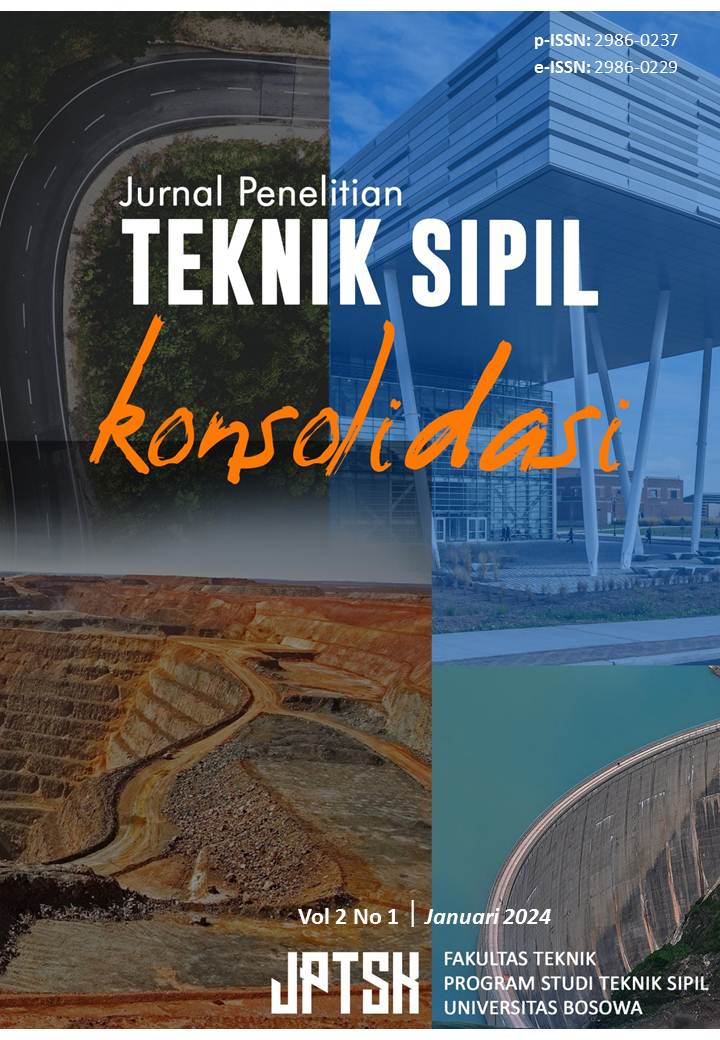Penggunaan Silika Fume Untuk Reduksi Semen Dengan Limbah Granit Sebagai Pengganti Agregat Kasar Terhadap Kuat Tekan Dan Kuat Tarik Beton
DOI:
https://doi.org/10.56326/jptsk.v2i1.3302Keywords:
Granite Waste, Silica Fume, Compressive Strength, Tensile StrengthAbstract
Concrete is a mixture of cement, sand, gravel, and water. In order to obtain good quality in the process, added ingredients, waste, or other materials with a certain ratio value are added. In this case, the use of granite waste as a substitute for coarse aggregate that is easy to find and the use of silica fume which aims to increase the compressive strength of concrete. The purpose of this study was to determine the effect of granite waste and silica fume, as well as the relationship between compressive strength and tensile strength of concrete with these variations. The percentage of granite waste and silica fume varied, ranging from 5%-10% granite waste and 0%, 7.5%, 15%, 22.5%, and 30% silica fume. Concrete testing was carried out after the concrete was 28 days old. The planned compressive strength is 25 Mpa. From the results obtained, the average normal concrete compressive strength was 27.69 Mpa and the average normal concrete tensile strength was 3.14 Mpa. The addition of 5% - 10% percentage granite waste and 0% silica fume obtained an average compressive strength of 27.74 Mpa and 27.65 Mpa, and an average tensile strength of 3.18 Mpa and 3.16 Mpa. The percentage of 10% granite waste and silica fume 7.5%, 15%, 22.5%, and 30% obtained average compressive strengths of 26.42 Mpa, 26.33 Mpa, 25.10 Mpa, and 25.01 Mpa respectively and average tensile strengths of 2.71 Mpa, 2.64 Mpa, 2.50 Mpa, and 2.41 Mpa respectively.
References
ASTM C 150, 2012. Standard Specification for Portland Cement, Annual Books of ASTM Standards, USA: Association of Standard Testing Materials.
ASTM C 1602, 2006. Standard Spesification for Mixing Water Used in the Production of Hydraulic Cement Concrete, Annual Books of ASTM Standards. USA: Association of Standard Testing Materials.
ASTM C 29, 2016. Standard Test Method of Bulk Density (“Unit Weight”) and Voids in Aggregate, Annual Books of ASTM Standards. USA: Association of Standard Testing Materials.
ASTM C 39, 2020. Standard Test Method for Compressive Strength of Cylindrical Concrete Specimens, Annual Books of ASTM Standards. USA: Association of Standard Testing Materials.
ASTM C 40, 2011. Standard Test Method for Organic Impurities in Fine Agregate for Concrete, Annual Books of ASTM Standards. USA: Association of Standard Testing Materials.
Bayrak, G., & Yilmaz, S. (2014). Bahan keramik kaca berbahan dasar granit. Acta Phys. Pol. A, 125(2), 623- 625.
Beton, Aplikasi, and Kinerja Tinggi. Semen Portland Di Indonesia.
CUBE, TIM. “Silica Fume, Sebagai Bahan Tambah Campuran Beton.” Ums.ac.id, 15 Dec. 2019, cube.ums.ac.id/2019/12/silica-fume-sebagai-bahan-tambah.html. Accessed 17 Apr. 2022.
HADI, SURYA. “Pengaruh Penambahan Limbah Granit Terhadap Kuat Tekan Beton.” GANEC SWARA, vol. 14, no. 1, 2020, pp. 476–480, journal.unmasmataram.ac.id/index.php/GARA/article/view/123/117. Accessed 17 Apr. 2022.
Mulyono, T., “Teknologi Beton”, Fakultas Teknik Universitas Negeri Jakarta, Jakarta. 2003
Neville, A. M. 1997. Properties of Concrete, Longman, and Final Ed., London.
Rahmadiyanto, Candra; Samekto, Muryati., “Teknologi Beton”, Penerbit Kanisius, Jakarta. 2001.
Simatupang, H. Partogi., 2017. Pengaruh Penambahan Silica Fume Terhadap Kuat Tekan Reactive Powder Concrete.
SNI 03-2834-2000, Tata Cara Pembuatan Rencana Campuran Beton Normal.
SNI 03-6821-2002, Spesifikasi Agregat Ringan untuk Batu Cetak Beton Pasangan Dindingl.
Susilo, Dwi Afif. 2012. Efek Penggantian Sebagian Semen Dengan Silica Fume Terhadap Berat Jenis Dan Kuat Tekan Beton Ringan.
Tjokrodimuljo, K,. 2003, Teknologi Bahan Konstruksi, Jurusan Teknik Sipil, Fakultas Teknik, Universitas Gajah Mada, Yogyakarta.
Tjokrodimuljo, K. (2007). Teknologi beton. Biro Penerbit Jurusan Teknik Sipil Fakultas Teknik UGM, Yogyakarta.
Tjokrodimuljo, K., 1995. Bahan Bangunan, Jurusan Teknik Sipil, Fakultas Teknik, Universitas Gajah Mada, Yogyakarta.
Wahyu Hudha Prasetya. “Inovasi High Early Strength Concrete Dengan Pemanfaatan Limbah Batu Granit, Cangkang Kerang Dan Fly Ash.” Jurnal Proyek Teknik Sipil, vol. 2, no. 2, 27Nov. 2019, pp. 31–41, ejournal2.undip.ac.id/index.php/potensi/article/view/6398, 10.14710/potensi.2019.6398. Accessed 17 Apr. 2022.
Wicaksono, Wahyu Satrio, et al. “Pengaruh Kadar Silica Fume Terhadap Kuat Tekan Pada High Strength Self Compacting Concrete (Hsscc) Benda Uji Silinder D 7,5 CM X 15 Cm Usia 14 Dan 28 Hari.” Matriks Teknik Sipil, vol. 6, no. 4, 11 Dec. 2018, jurnal.uns.ac.id/matriks/article/view/36537, 10.20961/mateksi.v6i4.36537. Accessed 17 Apr. 2022.
Downloads
Published
Issue
Section
License
Copyright (c) 2024 Rina Aswanti, Syahrul Sariman, Eka Yuniarto

This work is licensed under a Creative Commons Attribution 4.0 International License.










